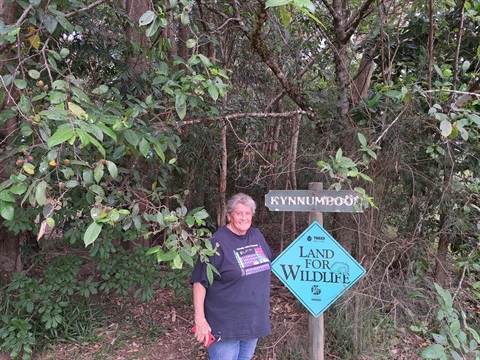Cane land restored to rainforest at Kynnumboon bringing wildlife back
03 April 2023

Beverley Fairley’s family has owned a farm on the Rous River at Kynnumboon near Murwillumbah since 1862 when her great grandfather settled there. The river and its forest formed the backdrop to 3 generations of Beverley’s family.
“We swam and played in the river, mucked about in boats, caught fish and enjoyed the wildlife, especially the birds. Back then, the river was the lifeblood of the community. To our family, the river was life,” Beverley said.
Although she loved growing up on the farm, Beverley moved away for work. While she was gone, she progressed her career and raised a family. In 2000, she returned to live permanently on the farm.
“As a farmer’s daughter and having played in the forest as a child, I knew about native trees and weeds. When I returned, I realised something was wrong,” she said.
“Weeds were choking the forest. The birds were gone. It looked like the forest was dying!”
Beverley sought help and got to work.
“I joined Landcare and got help from a local bush regenerator as well as my cousin. We worked out what the weeds were and how they were degrading the forest. After many walks, talks and cups of tea, we made a plan to restore the forest.
The first aim was to get rid of the cat’s claw creeper, an exotic vine that can smother entire trees.
“Even with herbicide, controlling it was laborious. The largest vines were so big we had to dig them up. We dug up most of the vines and also controlled giant devil’s fig, morning glory, lantana and camphor laurel,” Beverley said.
Beverley kept meticulous work records.
“Over 19 years, we removed 59, 760 cat’s claw tubers! Now, the forest is healthy and needs only occasional maintenance.”
Beverley also planted several thousand trees, now a thriving forest.
“The trees provide extra habitat and a nice climate around the house. They help stabilise the riverbank. My gardening committee, the birds, have brought in seed that has added to the forest,” she said.
Beverley’s journals show that her work has led to an increase in birdlife and other fauna.
“The birds are back! One bird group that visited recorded 29 species in 2 hours.”
It’s been a labour of love.
“I love my spot on the river and I haven’t let the heat, the rain, the mozzies or the snakes – which occasionally fall out of the trees – stop me,” she said.
Beverley’s story has an exciting new chapter. Her property was recently selected as the site for Council’s Bringing back flying-fox habitat to the Kynnumboon floodplain project, an 8-year project that involves planting 10,000 native trees, shrubs and groundcovers on ex-cane land to create rainforest and wetland habitat on the bank of the Rous River.
Projects like this one are part of Council’s commitment to looking after the Tweed’s internationally significant environment for future generations.
Read more about the project or for more information contact waterways project officer Matt Bloor at mbloor@tweed.nswgov.au or (02) 6670 2580.
Image (top): Beverley Fairley standing in front of the forest that she planted. Beverley is registered to Council’s Land for Wildlife program.

Image (circa 1942): Portion of original subtropical rainforest on the riverbank known as Bray’s Scrub. Beverley used to play in the forest here as a youngster.